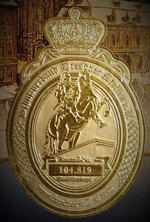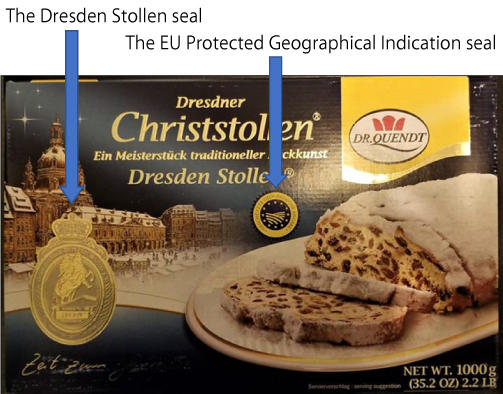Stollen, a Traditional Christmas Confection―The System Supporting the Quality of a Specialty Product (Part 1)
Osamu Magata
Professor, Faculty of Law, Chuo University
Area of Specialization: Criminal law
1. Stollen, the delight that ushers in Christmas
Stollen is a traditional German confection. They are large and moist, and since they are sliced thin before being served, they are similar to pound cake. They are full of dried fruit and give off a rich aroma of spices such as cinnamon. Powdered sugar is sprinkled on the top, reflecting the spirit of a white Christmas. In Germany, people begin eating them about a month or two before Christmas. (Supermarkets start displaying them as early as October.) Stollen is becoming increasingly popular in Japan, so many of you have probably heard of it.
2. Authentic stollen
In Germany, the home of delicious stollen, there are actually official definitions of what stollen is. These definitions are a set of regulations called "Guidelines for Quality Baked Goods."[1] These guidelines are not legally binding. However, they play a very significant role in stollen production, because they are used as the basis for assessing the composition and quality of products.[2]
These guidelines include rules on ingredients and production methods for stollen, as well as other products such as baumkuchen.
According to the guidelines, stollen must be made with a base ingredients such as flour, by adding butter or other milk fat (margarine, anhydrous milk fat, etc., can also be used) of at least 30% of the base ingredients weight, and dried fruit (including orange peel and lemon peel) of at least 60% of the base ingredients weight.
These are the main basic ingredients of stollen,[3] which are further subdivided as follows.
For the following types, at least 20% of the base ingredients weight:
(a) in almond should be added to make "almond stollen"
(b) in poppy seeds must be added to make "poppy seed stollen"
(c) in nuts must be added to make "nut stollen"
Additionally:
(d) At least 5% of the weight of the paste-like dough must be in marzipan to make "marzipan stollen."
(e) Butter of at least 40% of the base ingredients weight (which cannot be replaced by other fat products) and dried fruits (including orange peel and lemon peel) of at least 70% of the base ingredients weight must be added to make "butter stollen."
(f) There also is a type called "curd stollen," which contains curd that weighs 40% of the base ingredients weight, and butter or other milk fat that weighs 20% of the base ingredients weight. [4]
The fact that there are so many different kinds of stollen is delightful, and it seems to me that the Germans have a lot of love for stollen. Furthermore, as mentioned above, there are rules regarding the proportions of ingredients for various types of stollen, so a stollen baker cannot ignore these rules or sell stollen with a name that does not match the product (for example, a product cannot be sold as butter stollen when only a small amount of butter is used). In this way, the quality of the stollen is maintained (and the people's love for stollen is fulfilled).
3. The pinnacle of stollen: Dresden Stollen
(1) There is another kind of stollen that is, in a sense, important on another level. The stollen I am referring to is "Dresden Stollen."[5][6]

From the package of Echter Dresdner Christstollen manufactured by Dr. Quendt
(2) The first feature of Dresden Stollen is that it has been registered as a joint trademark with the German Patent and Trademark Office. The owner of this trademark is the Dresdner Christstollen e.V., and only the members of this association are allowed to produce and sell stollen bearing the name Dresden Stollen. The association also requires each supplier to produce high-quality stollen. This quality control is a mechanism to prevent quality deterioration. Dresden Stollen that is deemed worthy of shipment is marked with the Dresden Stollen seal (pictured on the right) with a control number as a quality assurance indicator.
(3) The second feature of Dresden Stollen is that under EU law,[7] it is designated as a product subject to geographical indication protection.[8][9][10] This allows the product to be sold with the EU Protected Geographical Indication seal (image below). This enables consumers to know that the stollen has been approved by the EU, and they can be assured that the products they purchase are high-quality stollen made using the traditional methods of the Dresden region. In this way, Dresden Stollen has established itself as a special brand of stollen.

From the website of the
German Federal Ministry of
Food and Agriculture
Incidentally, the European regulations stipulate the following detailed rules for the production of Dresden Stollen.
・ They must be shaped by hand.
・ They must not be baked in a baking pan.
・ They must weigh at least 500 grams.
・ At minimum, the following ingredients must be used: flour of type 405 or 550, whole milk or whole milk powder, granulated sugar, fresh or clarified butter, orange peel and/or lemon peel, sultanas, bitter almonds, sweet almonds, lemon zest, salt, powdered sugar, and spices.
・ The following ingredients must not be used: artificial flavors, direct food additives, and margarine.
・ The following ingredients must be added in the amounts listed, as percentages of the weight of the flour: fresh or clarified butter (50%), sultanas (65%), orange peel and/or lemon peel (20%), and bitter almonds and sweet almonds (15%).
These detailed rules help maintain the reputation of Dresden Stollen. Besides, since these are the minimum rules for production, each bakery adheres to these rules and adds its own unique combination of seasonings and baking methods to make its brand stand out and sell its own original flavor of Dresden Stollen.

The package of Echter Dresdner Christstollen manufactured by Dr. Quendt
(4) As mentioned above, the production methods for Dresden Stollen must adhere to detailed minimum requirements, and only a limited number of companies can produce and sell it. Therefore, other companies are prohibited from selling products under the Dresden Stollen name, because they would be considered imitation (fake) products.[11] In this way, the tradition and quality of Dresden Stollen are preserved, and the manufacturers (and their profits) are protected. (To be continued.)
[References] (For both Part 1 and Part 2)
In addition to the references indicated in the text, the following sources were used.
・ Hiroshi Takada, A Study on Legal Problems of Regional Brand Goods: Focusing on Legal Issues of Regional Outsiders, Meiji Gakuin Law Journal, vol. 106, pp. 13 ff.
・ Dev Gangjee, Protecting Geographical Indications as Collective Trademarks: The Prospects and Pitfalls, IIP Bulletin 2006, pp. 76 ff.
・ Kaori Minami, Oushu niokeru Chiriteki Hyouji Hogo Seido (Geographical Indication Protection Systems in Europe), Chizai Prizumu (Intellectual Property Prism), Vol. 15, No. 174, pp. 1 ff.
・ Reiko Tonomura, Chiriteki Hyouji Seido--Shouhyouhou tono Hikaku no Shiten kara (Geographical Indications System: A Comparative Perspective with Trademark Law), Patent Vol. 73, No. 2, pp. 45 ff.
[1] These guidelines are stipulated in Deutsches Lebensmittelbuch (the German Food Code). The German Food Code is based on Article 15 (German Food Code) and Article 16 (German Food Code Commission) of the Laws on Food, Household Goods and Feed (Lebensmittel-, Bedarfsgegenstände- und Futtermittelgesetzbuch).
[2] Source: the Bavarian Health and Food Safety Authority page (https://www.lgl.bayern.de/lebensmittel/warengruppen/wc_18_feine_backwaren/index.htm).
[3] If these basic ingredients are used, the product can be referred to as stollen. It may also be referred to as Christmas stollen or Christstollen. Source: https://www.vis.bayern.de/ernaehrung/lebensmittel/gruppen/stollen.htm ; https://www.verbraucherservice-bayern.de/presse/das-geheimnis-des-dresdner-christstollens
However, there is a court case (OLG Koblenz, LMRR 1982, 22) that pointed out that only stollen with half of the fat content made up of butter can be labeled as Der Beste (the best) based on the general understanding accepted in society. Source: Zipfel/Rathke, Lebensmittelrecht, C.-Teil 3.-308.- III.-1.-Rn.29
[4] The above is from the German "Guidelines for Quality Baked Goods" II, 9. Stollen under determining indicators.
[5] To be precise, the name is Dresdner Stollen, but since "Dresdner" means "from Dresden," "Dresden Stollen" is used in this paper for simplicity.
[6] As seen below, Dresden Stollen has been given special treatment, so to speak, because of its history as follows. The original form of stollen is called Strelzel, which was created in Saxony (the area including Dresden) in the 15th century. It was later improved and became stollen, which spread to Dresden. In the 17th century, bakers in Dresden acquired the privilege of selling only Dresden stollen at the Dresden Christmas market. In this way, the status of stollen as a Dresden product was established. Source: http://www.besuchen-sie-dresden.de/de/empfehlungen/dresdner-stollen-geschichte.php
[7] The legal basis for geographical indication protection is Regulation (EU) No. 1151/2012 of the European Parliament and of the Council on quality schemes for agricultural products and foodstuffs, Article 5 (2). Source: https://eur-lex.europa.eu/eli/reg/2012/1151/oj
[8] geschützte geografische Angabe (g.g.A) = Protected Geographical Indication (PGI). One of the geographical indications (GI) protected by the EU. Other examples include the Protected Designation of Origin.
[9] Registered under the rules of the European Commission in 2010. https://eur-lex.europa.eu/legal-content/EN/TXT/?uri=CELEX%3A32010R1098&qid=1606470452301
[10] The following video depicts a scene at the Dresden Stollen Festival, where speakers were delighted to announce the declaration of Dresden Stollen as a protected geographical indication product. https://youtu.be/DEovBHiReAU
[11] Those who try to sell such products in spite of these regulations may even resort to misusing the Dresden Stollen seal and the EU Protected Geographical Indication seal. In general, the misuse of the EU Protected Geographical Indication seal is increasing worldwide, and the EU is strengthening its measures. Source: JETRO report, "EU Geographical Indications (GI) Protection System," p. 3.
Osamu Magata
Professor, Faculty of Law, Chuo University
Area of Specialization: Criminal lawOsamu Magata was born in Tokyo in 1969. After graduating from the Faculty of Law, Chuo University, he obtained a doctoral degree in Criminal Law from the Graduate School of Law, Chuo University. After serving as an assistant professor at the Faculty of Law, Sapporo Gakuin University from 2003 and as an assistant professor at the Faculty of Law, Chuo University from 2005, he assumed his current position in 2010.
His research interests include re-examinations of complicity theory and preventive criminal law.
His research achievements include Kyohan no Honshitsu to Kabatsusei (The Essence and Criminal Liability of Complicity in a Crime) (single author), Keiho Enshu Subnote 210 Mon (210 Questions for Criminal Law Practice Subnotes) (co-authored), and Arrival of Singularity and Role of Criminal Law: Raising Issues, Hikakuho Zasshi (Comparative Law Review), Vol. 54, No. 4.









